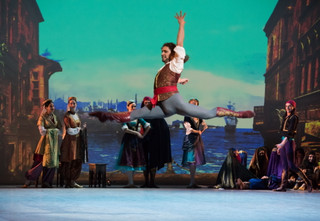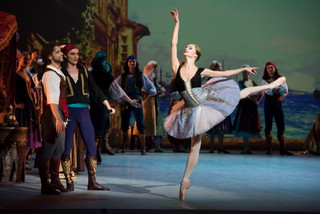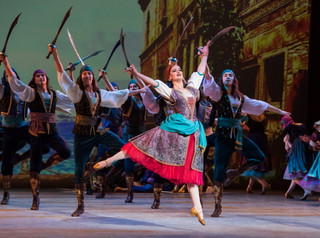|
Back
Swashbuckling Tour-de-Force Orange County
Segerstrom Hall
11/18/2016 - & 19, 20 November 2016
Le Corsaire (Choreography by Mikhail Messerer after Marius Petipa and Konstantin Sergeyev) (additional choreography by Joseph Mazilier, Jules Perrot, Alexander Gorsky and Pyotr Gusev)
Adolphe Adam, Cesare Pugni, Léo Delibes, Ludwig Minkus, Riccardo Drigo, Pyotr Oldenburgsky, Nikita Trubetskoy, Antoine Simon (Music)
Ekaterina Borchenko*/Angelina Vorontsova (Medora), Ivan Vasiliev*/Ivan Zaytsev (Conrad), Anastasia Soboleva*/Veronika Ignatyeva (Gulnare), Alexander Omar*/Andrey Kasyanenko (Birbanto), Alexy Malakhov (Seyd-Pasha), Roman Petukhov (Lanquedem), Miho Naotsuka*/Valeria Zapasnikova/Irina Zhalovskaya (Slave girl), Victor Lebedev*/Mario Labrador/Julian MacKay (Slave boy), Svetlana Bednenko/Andrea Lassáková/Deborah Davis (Odalisques), Mariam Ugrekhelidze/Kristina Makhviladze/Nina Osmanova/Vladimir Tsal/Denis Morozov (Soloists), the Mikhailovsky Orchestra and Corps de Ballet, Irina Levchenko (Flute), Pyotr Danilov (Oboe), Dmitry Makarov (Trumpet), Vladimir Antonov (Horn), Pavel Klinichev (Conductor), Mikhail Messerer (Stage Director), Vyacheslav Okunev (Set Designer), Tatiana Yastrebova (Costume Designer), Alexander Kibitkin (Lighting Designer)

(© Doug Gifford)
If the name Mikhailovsky Ballet doesn’t readily turn heads within Orange County, it soon will. The little known secret gem of a dance company has been in existence since 1833 at the behest of Tsar Nicholas I, almost as long as the venerable titan Bolshoi down the street. The Company made its West Coast premiere of Boris Asafiev’s full-length Les Flammes de Paris (The Flames of Paris) featuring power hunk Ivan Vasiliev in 2014. Adding to ballet “firsts” we are again graced by Mikhailovsky’s and Vasiliev’s return in this American premiere production of Le Corsaire.
One of Russia’s “Big Five”, Le Corsaire has been around for over 150 years filled with political intrigue and bestowed with the distinguished notoriety of being voraciously recobbled not only in music but through choreography. In this Le Corsaire the line of continuity generally moves forward from the time Marius Petipa assumed a supervisory role for Moscow’s new 1888 production. After a period of fluctuating interpretations, Konstantin Sergeyev, whose appearance in 1973, reinstated Petipa’s vision originale by supplementing his own imprint of selections. Enter the Messerer family, a dynasty for over 100 years whose expertise tapped into the very fibre of balletic finery and winding up to where we are on stage today with Maître de ballet, Mikhail Messerer. What’s important is the regard of philosophy behind this production: melding of classical Russian [Vaganova] ballet with Soviet bravura which gives this Le Corsaire a “reaching across the aisle” stance with an obsequiously modest modern glance. The result is respectful, redefining and reinvigorating.
Lord Byron’s moody poem doesn’t necessarily fit well inside M. Messerer’s outreach for this production is colorful, lively and steeped in Vyacheslav Okunev’s Turkish anthropological detail and emboldened through the extravagant costuming by Tatiana Yastrebova. Pavel Klinichev insistently puts wind in the pirates’ sails as he pushes and tugs at the tempo: he’s our own buccaneer while commanding the orchestra which never lulls. His pulls uncover the finest from the pit with prickly intricacy, allowing dancers to starchly pop, much to the audience’s delight: Irina Levchenko’s flute adds immeasurable dulcet equations while oboeist Pyotr Danilov elicits seductively exotic charm to magnify the movement on stage.
Some of the composers (re: contributors to the original score) have been scuttled while others made the “list.” We’re off to a good start by the unveiling of a lively “Danse des forbans” set to the music by Cesare Pugni. Alexander Omar ushers in the gymnastic spectacle as Conrad’s friend, Birbanto. He creates very sufficient amount of tension to hold the drama together. Mikhail Messerer’s sword fights have genuine palpability and generate excitement throughout the evening.
If one followed last year’s Raymonda, one can discern detailing from M. Sergeyev’s choreography. There is an undeniable link to the French discipline that adds nuances of delicacy amidst raucous frivolity. Miho Naotsuka and Victor Lebedev combine their energies to create an impressive Pas d’esclaves (music by Pyotr Oldenburgsky) though Mlle. Naotsuka’s start is a tad light. We’re dazzled by the Pas des tres odalisques including clean formations by Svetlana Bednenko, Andrea Lassáková and Deborah Davis.
The evening’s biggest power house emanates from Ivan Vasiliev. One look at his rugged dominance makes one think he’s the ultimate pirate. It’s been earlier annotated Ivan Vasiliev as “Sex on legs”… if this seems a mere exaggeration, it is not! His incredible musculature permits him to execute jaw-dropping, unintimidating grands jetés unlike any other. His turns sparkle with uncompromising precision. (His earlier gyrations in Act I got ahead of him as he saved himself from a bad spill and regained composure.)

(© Doug Gifford)
Filling the shoes as the female protagonist, Ekaterina Borchenko delivers superb elegance as Medora with smoothly lined arches; the arabesques reveal creamy softness, yet they are convincingly fleeting and oblique. The end result yields suave crispness. Alongside M. Vasiliev, the duo makes a formidable team inside the Grand pas de deux. They are completely aligned with M. Klinichev’s music, and the climax note brings appropriate frisson.

(© Doug Gifford)
An element of “comic relief” comes by way of Alexey Malakhov as Seyd-Pasha with his grandiose entrée onto the stage via an opulent palanquin. The thinly vulgar pantomiming whiffs back to Bournonville with a handful of meddlesome, exaggerated gesticulations, especially when Anastasia Soboleva dances for her master in Act III: Gulnare is a “tease”, well caricatured, fluffed by whimsical charm while jabbing her master with coquettish innuendos that aid in unraveling the plot involving fellow Medora. Unfortunately, Malakhov’s miming mildly obfuscates Gulare’s pas.
Handled behind a translucent scrim, we’re entranced by the Petipa-derived divertissement, “Le Jardin animé” with its ethereal lines of diagonals and geometric symmetry. Dressed in a soft pink palette, the female corps de ballet adds their own touch of gracefulness, helping structure variations executed by Mlles. Naotsuka and Borchenko though the formations occasionally liquidate.
We find ourselves ensconced within a five-tier Byzantine-like proscenium arch which provides a scenic three dimensional outreach with graphics on the back wall to give veritable perspective and realism. The pièce de résistance sets course when Conrad and Medora embark and the ship unmoors (there’s no shipwreck), sailing off into the sunset amidst a bevy of clouds. This magical closing is one of the loveliest coup de théâtre sights in ballet.
Mikhail Messerer is to be lauded on all fronts for he gives new meaning to Le Corsaire. Three words come to mind: thoughtful, rugged elegance. Absolutely superb. Bravo!
Christie Grimstad
|